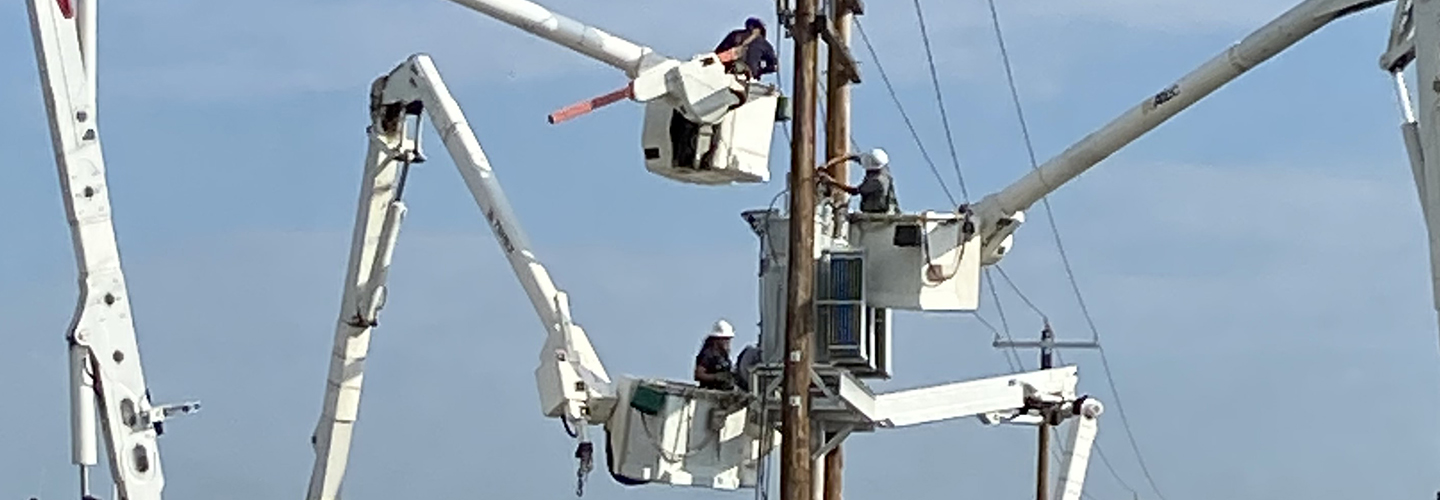Mutual Assistance: a unique network of sharing
After the storm, here’s how utilities rally for recovery

You’ve seen the dramatic images – roofless buildings, flipped cars, broken windows, a line of power poles pulled down. Just a few testaments of how powerful storms can leave astonishing destruction.
As communities pick up, clean up and recover, the massive task of restoring electric power is often beyond the capabilities of local utilities. So major disasters are answered by Edison Electric Institute’s (EEI) Mutual Assistance Program, a voluntary partnership of investor-owned electric companies from across the country that mobilizes to help speed restoration to major outage events.
Electric companies impacted can, in effect, “borrow” restoration workers from other utilities in the region. This can include line workers, tree trimmers, damage assessors, and even call center support. The objective is to restore power quickly and safely by clearing debris, rebuilding power lines and replacing poles.
How Xcel Energy answers mutual assistance requests
Kelly Bloch, Regional Vice President for Distribution Operations with Xcel Energy, states, “We’re always watching the weather to see where a major event may happen. We’re pretty good at estimating when a request will come our way. Then we determine our ability to respond by how vulnerable we may be to storms in our area and maintaining our ongoing projects.”
Usually, Xcel Energy contractors are first asked to participate in a Mutual Assistance request. When a Mutual Assistance call requires a more considerable amount of support, Xcel Energy employees are engaged. In most years, Xcel Energy answers one to four Mutual Assistance requests.
What’s it like for line workers offering mutual assistance?
Responding to a Mutual Assistance request, Xcel Energy sends a turn-key group. This group includes line workers along with the full support they need to be as productive as possible. This involves managers, mechanics, safety and occasionally damage assessment staff, all working as a self-sufficient team on location.
Critical to each Mutual Assistance project is a staging site. Here’s where the host utility provides a secure place for the crews to use as a base for their operations. In addition to being able to access the materials needed to perform the restoration work there are often giant tents with cots, mess halls, portable showers and other necessities are placed. Or, buses will shuttle workers to and from local hotels or college dormitories.
Crews typically work 16-hour shifts with eight hours for rest. Large Mutual Assistance efforts such as with Hurricanes can last two to three weeks.
Operating in the new COVID-19 reality
With the new safety and social distancing requirements of COVID-19, Mutual Assistance programs have adapted. Now, more separated accommodations are needed, along with smaller gathering places. For example, sharing specifics about the local power system and other details previously took place at a meeting at the staging area. These are now sent via electronic documents and voice messages. While crews miss out on some of the camaraderie, the new process is proving to be effective.
Click on above image to watch video.
Our Puerto Rico story
One of the most prolific Mutual Assistance projects was for Hurricane Maria, a devastating Category 4 storm that made landfall in Puerto Rico in September 2017. All critical infrastructure and least 80 percent of the island's energy grid was severely damaged.
Nearly 60 power utilities provided approximately 3,000 line workers and support personnel to take on the task in tropical heat and ruined infrastructure.
Logistical challenge
For Xcel Energy, the project started with six weeks of prep, moving trucks and equipment to the Gulf Coast and then onto barges for 10-days of ocean travel. Crews flew to Puerto Rico where three teams rotated three-week durations. Line workers rose to the challenge and made positive impacts with many island communities.
Other Mega-Mutual Assistance responses
- Superstorm Sandy in October 2012, 10 million customers lost power across 24 states in the Northeast and Mid-Atlantic. 80 utilities respond.
- The June 2012 Derecho—a sudden and widespread storm with peak wind gusts ranging from 80–100 miles per hour—four million people lose power across Ohio and the Mid-Atlantic. 30,000, company workers and crews from as far away as Canada, Texas, and Wyoming.
- In August 2011, Hurricane Irene hit the East Coast, nine million customers without power. Nearly 50,000 electric company restoration workers respond.
- Hurricane Katrina hit the Gulf of Mexico in August 2005, damaging a 400-mile section of coastline across Louisiana, Mississippi, Alabama and western Florida, destroying the energy grid. More than 46,000 electric company restoration workers and contractors respond.
Come home safe
Kelly Bloch continues, “For us, safety is the overall priority. Making sure the public is kept safe during traumatic times and keeping our crews safe as they do what they do best, get the power back on.”
Be ready for an outage
To help keep you and your family safe during storms and outages, use our resource page.



